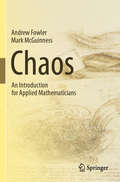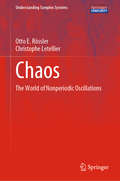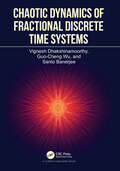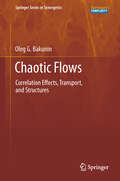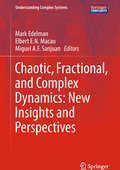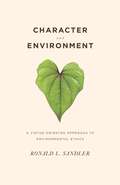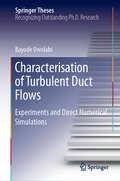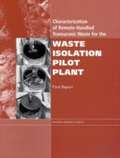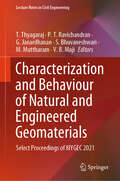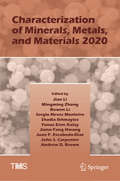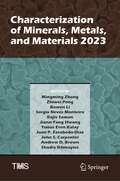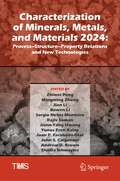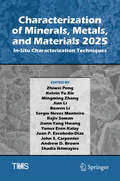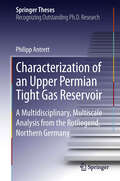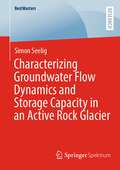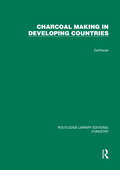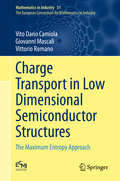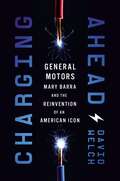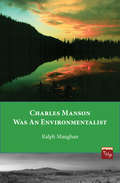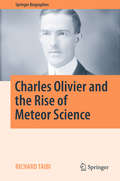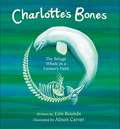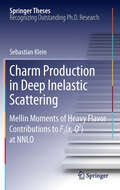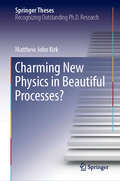- Table View
- List View
Chaos: An Introduction for Applied Mathematicians
by Andrew Fowler Mark McGuinnessThis is a textbook on chaos and nonlinear dynamics, written by applied mathematicians for applied mathematicians. It aims to tread a middle ground between the mathematician's rigour and the physicist’s pragmatism.While the subject matter is now classical and can be found in many other books, what distinguishes this book is its philosophical approach, its breadth, its conciseness, and its exploration of intellectual byways, as well as its liberal and informative use of illustration. Written at the graduate student level, the book occasionally drifts from classical material to explore new avenues of thought, sometimes in the exercises. A key feature of the book is its holistic approach, encompassing the development of the subject since the time of Poincaré, and including detailed material on maps, homoclinic bifurcations, Hamiltonian systems, as well as more eclectic items such as Julia and Mandelbrot sets. Some of the more involved codes to produce the figures are described in the appendix.Based on lectures to upper undergraduates and beginning graduate students, this textbook is ideally suited for courses at this level and each chapter includes a set of exercises of varying levels of difficulty.
Chaos: The World of Nonperiodic Oscillations (Understanding Complex Systems #Vol. 84)
by Otto E. Rössler Christophe LetellierWritten in the 1980s by one of the fathers of chaos theory, Otto E. Rössler, the manuscript presented in this volume eventually never got published. Almost 40 years later, it remains astonishingly at the forefront of knowledge about chaos theory and many of the examples discussed have never been published elsewhere. The manuscript has now been edited by Christophe Letellier - involved in chaos theory for almost three decades himself, as well as being active in the history of sciences - with a minimum of changes to the original text.Finally released for the benefit of specialists and non-specialists alike, this book is equally interesting from the historical and the scientific points of view: an unconventionally modern approach to chaos theory, it can be read as a classic introduction and short monograph as well as a collection of original insights into advanced topics from this field.
Chaotic Dynamics of Fractional Discrete Time Systems
by Santo Banerjee Vignesh Dhakshinamoorthy Guo-Cheng WuThe book reviews the application of discrete fractional operators in diverse fields such as biological and chemical reactions, as well as chaotic systems, demonstrating their applications in physics. The dynamical analysis is carried out using equilibrium points of the system for studying their stability properties and the chaotic behaviors are illustrated with the help of bifurcation diagrams and Lyapunov exponents.The book is divided into three parts. Part I deals with the application of discrete fractional operators in chemical reaction-based systems with biological significance. Two different chemical reaction models are analysed- one being disproportionation of glucose, which plays an important role in human physiology and the other is the Lengyel – Epstein chemical model. Chaotic behavior of the systems is studied and the synchronization of the system is performed. Part II covers the analysis of biological systems like tumor immune system and neuronal models by introducing memristor based flux control. The memductance functions are considered as quadratic, periodic, and exponential functions. The final part of the book reviews the complex form of the Rabinovich-Fabrikant system which describes physical systems with strong nonlinearity exhibiting unusual behavior.
Chaotic Flows: Correlation Effects, Transport, and Structures (Springer Series in Synergetics #10)
by Oleg G. BakuninThe book introduces readers to and summarizes the current ideas and theories about the basic mechanisms for transport in chaotic flows. Typically no single paradigmatic approach exists as this topic is relevant for fields as diverse as plasma physics, geophysical flows and various branches of engineering. Accordingly, the dispersion of matter in chaotic or turbulent flows is analyzed from different perspectives. Partly based on lecture courses given by the author, this book addresses both graduate students and researchers in search of a high-level but approachable and broad introduction to the topic.
Chaotic, Fractional, and Complex Dynamics: New Insights and Perspectives (Understanding Complex Systems)
by Miguel A. F. Sanjuan Mark Edelman Elbert E. N. MacauThe book presents nonlinear, chaotic and fractional dynamics, complex systems and networks, together with cutting-edge research on related topics. The fifteen chapters - written by leading scientists working in the areas of nonlinear, chaotic, and fractional dynamics, as well as complex systems and networks - offer an extensive overview of cutting-edge research on a range of topics, including fundamental and applied research. These include but are not limited to, aspects of synchronization in complex dynamical systems, universality features in systems with specific fractional dynamics, and chaotic scattering. As such, the book provides an excellent and timely snapshot of the current state of research, blending the insights and experiences of many prominent researchers.
Character and Environment: A Virtue-Oriented Approach to Environmental Ethics
by Ronald SandlerVirtue ethics is now widely recognized as an alternative to Kantian and consequentialist ethical theories. However, moral philosophers have been slow to bring virtue ethics to bear on topics in applied ethics. Moreover, environmental virtue ethics is an underdeveloped area of environmental ethics. Although environmental ethicists often employ virtue-oriented evaluation (such as respect, care, and love for nature) and appeal to role models (such as Henry Thoreau, Aldo Leopold, and Rachel Carson) for guidance, environmental ethics has not been well informed by contemporary work on virtue ethics. With Character and Environment, Ronald Sandler remedies each of these deficiencies by bringing together contemporary work on virtue ethics with contemporary work on environmental ethics. He demonstrates the many ways that any ethic of character can and should be informed by environmental considerations. He also develops a pluralistic virtue-oriented environmental ethic that accommodates the richness and complexity of our relationship with the natural environment and provides effective and nuanced guidance on environmental issues. These projects have implications not only for environmental ethics and virtue ethics but also for moral philosophy more broadly. Ethical theories must be assessed on their theoretical and practical adequacy with respect to all aspects of the human ethical situation: personal, interpersonal, and environmental. To the extent that virtue-oriented ethical theory in general, and Sandler's version of it in particular, provides a superior environmental ethic to other ethical theories, it is to be preferred not just as an environmental ethic but also as an ethical theory. Character and Environment will engage any reader with an interest in environmental ethics, virtue ethics, or moral philosophy.
Characterisation of Turbulent Duct Flows: Experiments and Direct Numerical Simulations (Springer Theses)
by Bayode OwolabiThis book presents several new findings in the field of turbulent duct flows, which are important for a range of industrial applications. It presents both high-quality experiments and cutting-edge numerical simulations, providing a level of insight and rigour rarely found in PhD theses. The scientific advancements concern the effect of the Earth’s rotation on large duct flows, the experimental confirmation of marginal turbulence in a pressure-driven square duct flow (previously only predicted in simulations), the identification of similar marginal turbulence in wall-driven flows using simulations (for the first time by any means) and, on a separate but related topic, a comprehensive experimental study on the phenomenon of drag reduction via polymer additives in turbulent duct flows. In turn, the work on drag reduction resulted in a correlation that provides a quantitative prediction of drag reduction based on a single, measurable material property of the polymer solution, regardless of the flow geometry or concentration. The first correlation of its kind, it represents an important advancement from both a scientific and practical perspective.
Characterization Of Remote-handled Transuranic Waste For The Waste Isolation Pilot Plant: Final Report
by Committee on the Characterization of Remote-Handled Transuranic Waste for the Waste Isolation Pilot PlantThe U.S. Department of Energy (DOE) disposes of plutonium-contaminated debris from its 27 nuclear weapons facilities at the Waste Isolation Pilot Plant (WIPP), an underground repository in Carlsbad, New Mexico. After four years of operational experience, DOE has opportunities to make changes to the costly and time-consuming process of "characterizing" the waste to confirm that it is appropriate for shipment to and disposal at WIPP. The report says that in order to make such changes, DOE should conduct and publish a systematic and quantitative assessment to show that the proposed changes would not affect the protection of workers, the public, or the environment.
Characterization and Behaviour of Natural and Engineered Geomaterials: Select Proceedings of 8IYGEC 2021 (Lecture Notes in Civil Engineering #420)
by V. B. Maji M. Muttharam T. Thyagaraj P. T. Ravichandran G. Janardhanan S. BhuvaneshwariThis book presents the select proceedings of the 8th Indian Young Geotechnical Engineers Conference (8IYGEC 2021) on the following conference themes: Characterization and Behaviour of Saturated and Unsaturated Geomaterials, Geoenvironmental Engineering, Geotechnical Investigation and Spatial Analysis and Offshore and Marine Geotechnology. The book covers a wide range of topics on characterization and behaviour of natural and engineered geomaterials, which include soil suction characteristics, hydraulic and volume change behaviour of clay liners, collapse behaviour, contaminant transport, phytoremediation, microbial characterization and biochar-amended soil in landfill covers, stabilization of soils, etc. This book can be a valuable reference for academicians and practicing engineers.
Characterization of Minerals, Metals, and Materials 2020 (The Minerals, Metals & Materials Series)
by Jian Li Jiann-Yang Hwang Shadia Ikhmayies John S. Carpenter Sergio Neves Monteiro Mingming Zhang Bowen Li Juan P. Escobedo-Diaz Yunus Eren Kalay Andrew D. BrownThis collection gives broad and up-to-date results in the research and development of materials characterization and processing. Topics covered include advanced characterization methods, minerals, mechanical properties, coatings, polymers and composites, corrosion, welding, magnetic materials, and electronic materials. The book explores scientific processes to characterize materials using modern technologies, and focuses on the interrelationships and interdependence among processing, structure, properties, and performance of materials.
Characterization of Minerals, Metals, and Materials 2023 (The Minerals, Metals & Materials Series)
by Jiann-Yang Hwang Shadia Ikhmayies John S. Carpenter Sergio Neves Monteiro Mingming Zhang Bowen Li Zhiwei Peng Juan P. Escobedo-Diaz Yunus Eren Kalay Rajiv Soman Andrew D. BrownThe collection focuses on the advancements of characterization of minerals, metals, and materials and the applications of characterization results on the processing of these materials. Advanced characterization methods, techniques, and new instruments are emphasized. Areas of interest include, but are not limited to:· Extraction and processing of various types of minerals, process-structure-property relationship of metal alloys, glasses, ceramics, polymers, composites, semiconductors, and carbon using as functional and structural materials. · Novel methods and techniques for characterizing materials across a spectrum of systems and processes. · Characterization of mechanical, thermal, electrical, optical, dielectric, magnetic, physical, and other properties of materials. · Characterization of structural, morphological, and topographical natures of materials at micro- and nano- scales. · Characterization of extraction and processing including process development and analysis. · Advances in instrument developments for microstructure analysis and performance evaluation of materials, such as computer tomography (CT), X-ray and neutron diffraction, electron microscopy (SEM, FIB, TEM), and spectroscopy (EDS, WDS, EBSD) techniques. · 2D and 3D modelling for materials characterization.
Characterization of Minerals, Metals, and Materials 2024: Process–Structure–Property Relations and New Technologies (The Minerals, Metals & Materials Series)
by Jian Li Jiann-Yang Hwang Shadia Ikhmayies John S. Carpenter Sergio Neves Monteiro Mingming Zhang Bowen Li Zhiwei Peng Juan P. Escobedo-Diaz Yunus Eren Kalay Rajiv Soman Andrew D. BrownThe collection focuses on the advancements of characterization of minerals, metals, and materials and the applications of characterization results on the processing of these materials. Advanced characterization methods, techniques, and new instruments are emphasized. Areas of interest include, but are not limited to:· Extraction and processing of various types of minerals, process-structure-property relationship of metal alloys, glasses, ceramics, polymers, composites, semiconductors, and carbon using functional and structural materials. · Novel methods and techniques for characterizing materials across a spectrum of systems and processes. · Characterization of mechanical, thermal, electrical, optical, dielectric, magnetic, physical, and other properties of materials. · Characterization of structural, morphological,and topographical natures of materials at micro- and nano- scales. · Characterization of extraction and processing including process development and analysis. · Advances in instrument developments for microstructure analysis and performance evaluation of materials, such as computer tomography (CT), X-ray and neutron diffraction, electron microscopy (SEM, FIB, TEM), and spectroscopy (EDS, WDS, EBSD) techniques. · 2D and 3D modelling for materials characterization.
Characterization of Minerals, Metals, and Materials 2025: In-Situ Characterization Techniques (The Minerals, Metals & Materials Series)
by Jian Li Jiann-Yang Hwang Shadia Ikhmayies John S. Carpenter Sergio Neves Monteiro Mingming Zhang Bowen Li Zhiwei Peng Juan P. Escobedo-Diaz Yunus Eren Kalay Rajiv Soman Andrew D. Brown Kelvin Yu XieThe collection focuses on the advancements of characterization of minerals, metals, and materials and the applications of characterization results on the processing of these materials. Advanced characterization methods, techniques, and new instruments are emphasized. Areas of interest include but are not limited to: Extraction and processing of various types of minerals, process-structure-property relationship of metal alloys, glasses, ceramics, polymers, composites, semiconductors, and carbon using functional and structural materials Novel methods and techniques for characterizing materials across a spectrum of systems and processes Characterization of mechanical, thermal, electrical, optical, dielectric, magnetic, physical, and other properties of metals, polymers, and ceramics including battery materials Characterization of structural, morphological, and topographical natures of materials at micro- and nano-scales Characterization of extraction and processing including process development and analysis Advances in instrument development for microstructure analysis and performance evaluation of materials, such as computer tomography (CT), X-ray and neutron diffraction, electron microscopy (SEM, FIB, TEM), and spectroscopy (EDS, WDS, EBSD) techniques 2D and 3D modelling for materials characterization
Characterization of Zeolite-Based Coatings for Adsorption Heat Pumps (SpringerBriefs in Applied Sciences and Technology)
by Angelo Freni Belal Dawoud Lucio Bonaccorsi Stefanie Chmielewski Andrea Frazzica Luigi Calabrese Giovanni RestucciaThis book proposes a radically new approach for characterizing thermophysical and mechanical properties of zeolite-based adsorbent coatings for Adsorptive Heat Transformers (AHT). It presents a developed standard protocol for the complete characterization of advanced coated adsorbers. Providing an in-depth analysis of the different procedures necessary for evaluating the performance of adsorbers, it also presents an analysis of their stability under the hydrothermal and mechanical stresses during their entire life cycle. Adsorptive Heat Transformers (AHT), especially adsorption chillers and heat pumps, are considered to be promising technologies to increase thermal energy efficiency. Nevertheless, an overall increase in performance of this apparatus is necessary for them to be considered a mature technology to be used commercially. Development of innovative coated adsorbers can be perceived as a key issue for the enhancement of AHT technology. This procedure relies on the deposition, either by means of a binder or by direct crystallization, of the adsorbent material over a metallic heat exchanger, aiming at the improvement of the heat transfer between the external heat source and the adsorbent itself. This book offers a valuable resource to those working on the development of novel adsorbent materials and advanced adsorbent beds for heating and cooling applications. It is also intended for researchers interested in renewable energy and energy efficiency.
Characterization of an Upper Permian Tight Gas Reservoir: A Multidisciplinary, Multiscale Analysis from the Rotliegend, Northern Germany (Springer Theses)
by Philipp Antrett"The thesis of Philipp Antrett is focused on reservoir properties, petrography, lithofacies and sedimentology, core analysis and nanoporosity studies. It will be of major interest for colleagues involved in the exploration and production of tight gas reservoirs in Northern Europe and elsewhere." - François Roure, August 2012 This thesis describes a multidisciplinary, multiscale approach to the analysis of tight gas reservoirs. It focused initially on the facies architecture of a Permian tight gas field in the Southern Permian Basin (SPB), East Frisia, northern Germany. To improve field development, 3D seismic data, wireline and core data were compared to a reservoir analogue in the Panamint Valley, California, United States. In addition to the large scale approach, a work flow that investigates microporosity by combining Scanning Electron Microscopy-Broad Ion Beam (SEM-BIB) and optical microscopy was developed. For a better understanding of the depositional environment and reservoir rock distribution in the SPB, a sedimentary facies analysis of four cores from the tight gas field in East Frisia was compared to a second study area in northern central Germany. This study demonstrates that tight gas exploration and production requires multidisciplinary, multiscale approaches beyond standard seismic interpretation work flows to better understand the temporal and spatial evolution of these complex reservoirs.
Characterizing Groundwater Flow Dynamics and Storage Capacity in an Active Rock Glacier (BestMasters)
by Simon KainzAlpine aquifers play a critical role in the hydrology of mountainous areas by sustaining base flow in downstream rivers during dry periods and retarding flood propagation after heavy precipitation events. Progressing climate change alters climatic and meteorological boundary conditions as well as the hydraulic response of alpine catchments by ablating glaciers and thawing permafrost. Rock glaciers exert a controlling influence on the catchment response due to their prominent groundwater storage and complex drainage characteristics. This thesis investigates the hydrogeology and internal structure of the active rock glacier Innere Ölgrube (Ötztal Alps), which governs catchment runoff and is affected by permafrost degradation. A 3D geometrical model of its internal structure is obtained by combining geophysical data and permafrost creep modelling. Available data and new results are integrated into a conceptual hydrogeological model providing a sound basis for the implementation of a prospective numerical groundwater flow model. Hydraulic properties of the hydrostratigraphic units constituting the rock glacier are estimated and groundwater recharge fluxes quantified. Fundamental properties of the heterogeneous groundwater flow system within the rock glacier are discussed and compared to existing rock glacier studies.
Charcoal Making in Developing Countries (Routledge Library Editions: Forestry)
by Gerald FoleyOriginally published in 1986, this book provides a detailed examination of programmes to introduce improved charcoal making techniques throughout the developing world. Charcoal making is widely regarded as an extremely wasteful use of scarce wood resources. The book includes a section on the physics and chemistry of charcoal and descriptions of the various traditional methods of charcoal making. Patterns of charcoal supply and distribution are analysed and efforts to introduce improved charcoal making techniques are described and evaluated.
Charge Transport in Low Dimensional Semiconductor Structures: The Maximum Entropy Approach (Mathematics in Industry #31)
by Vittorio Romano Vito Dario Camiola Giovanni MascaliThis book offers, from both a theoretical and a computational perspective, an analysis of macroscopic mathematical models for description of charge transport in electronic devices, in particular in the presence of confining effects, such as in the double gate MOSFET. The models are derived from the semiclassical Boltzmann equation by means of the moment method and are closed by resorting to the maximum entropy principle. In the case of confinement, electrons are treated as waves in the confining direction by solving a one-dimensional Schrödinger equation obtaining subbands, while the longitudinal transport of subband electrons is described semiclassically. Limiting energy-transport and drift-diffusion models are also obtained by using suitable scaling procedures. An entire chapter in the book is dedicated to a promising new material like graphene. The models appear to be sound and sufficiently accurate for systematic use in computer-aided design simulators for complex electron devices. The book is addressed to applied mathematicians, physicists, and electronic engineers. It is written for graduate or PhD readers but the opening chapter contains a modicum of semiconductor physics, making it self-consistent and useful also for undergraduate students.
Charging Ahead: GM, Mary Barra, and the Reinvention of an American Icon
by David WelchMary Barra&’s quest to move GM to a manufacturer of electric cars has captured the attention of automobile aficionados, green-business advocates, and leaders of all types who have to admire Mary&’s toughness in moving forward despite the overwhelming obstacles in her path.A decade ago, no one would have guessed that GM would be the company poised to lead America into the future. At a time when business book readers seem endlessly fascinated by soaring tech giants like Amazon and Netflix, and ill-fated startups like WeWork and Theranos, why is it important to put the spotlight back on 112-year-old GM? Because Charlie Wilson&’s quip from 1952 is still true: What&’s good for GM is still good for America, and vice versa. America needs to transition to a new era of clean energy and environmentally sustainable transportation. We also need to adapt to a world with far fewer assembly-line jobs, but far more skilled jobs for people who can design, build, and operate robots and other high-tech machines. GM&’s attempt to lead those transitions is as important as it is dramatic.Equally compelling is the story of GM&’s CEO, Mary Barra, who against all odds took the reins at GM in 2014. Since that time, she has attempted to reinvent a century-old company and equip it for the biggest change in transportation since the internal combustion engine replaced the horse. In the process, she has been ripping out GM traditions by the roots—and taking flak from all sides. Her plan is to make GM—the company famed for the gas-burning Corvette, hulking Cadillac Escalade, and carbon-spewing Silverado pickup—purely electric and clean by 2035. She may not be as wealthy as Jeff Bezos, as brash as Elon Musk, or as powerful as Mark Zuckerberg, but Mary Barra is just as important as any of them. And as one of the most powerful female executives in the world, she is overdue for an in-depth look at her forward-thinking vision, her approach to leadership, and her accomplishments against the odds.
Charles Manson was an Environmentalist
by Ralph MaughanIn the fall of 1979, millions of some of the most beautiful acres in the world were under threat. The political heat surrounding the environmental controversy prompted then Senator Frank Church to wear a bullet proof vest to public hearings. This is Ralph Maughan's personal story of the courageous creation of the Frank Church - River of No Return Wilderness.
Charles Olivier and the Rise of Meteor Science (Springer Biographies)
by Richard TaibiThis fascinating portrait of an amateur astronomy movement tells the story of how Charles Olivier recruited a hard-working cadre of citizen scientists to rehabilitate the study of meteors. By 1936, Olivier and members of his American Meteor Society had succeeded in disproving an erroneous idea about meteor showers. Using careful observations, they restored the public's trust in predictions about periodic showers and renewed respect for meteor astronomy among professional astronomers in the United States. Charles Olivier and his society of observers who were passionate about watching for meteors in the night sky left a major impact on the field. In addition to describing Olivier's career and describing his struggles with competitive colleagues in a hostile scientific climate, the author provides biographies of some of the scores of women and men of all ages who aided Olivier in making shower observations, from the Leonids and Perseids and others. Half of these amateur volunteers were from 13 to 25 years of age. Their work allowed Olivier and the AMS to contradict the fallacious belief in stationary and long-enduring meteor showers, bringing the theory of their origin into alignment with celestial mechanics. Thanks to Olivier and his collaborators, the study of meteors took a great leap forward in the twentieth century to earn a place as a worthy topic of study among professional astronomers.
Charles Taylor’s Ecological Conversations: Politics, Commonalities And The Natural Environment
by Glen LehmanThe author uses the work of the eminent Canadian philosopher, Charles Taylor, to develop a critique of those political perspectives that are based on instrumental ways to reason about the world, claiming that such perspectives invariably sever the connections between the social and natural worlds.
Charlotte's Bones: The Beluga Whale In A Farmer's Field (Tilbury House Nature Book #0)
by Erin Rounds Alison CarverMany thousands of years ago, when a sheet of ice up to a mile thick began to let go of the land, the Atlantic Ocean flooded great valleys that had been scooped out by glaciers, and the salty waves of an inland sea lapped the green hills of Vermont. Into this arm of the sea swam Charlotte. Her milky, smooth, muscled body sliced slowly through the water like scissors through silk. Like a chirping canary, her voice echoed across dark waters showing the way to her pod as belugas have done for millions of years. In 1849, a crew building a railroad through Charlotte, Vermont, dug up strange and beautiful bones in a farmer’s field. A local naturalist asked Louis Agassiz to help identify them, and the famous scientist concluded that the bones belonged to a beluga whale. But how could a whale’s skeleton have been buried so far from the ocean? The answer—that Lake Champlain had once been an arm of the sea—encouraged radical new thinking about geological time scales and animal evolution. Charlotte’s Bones is a haunting, science-based reconstruction of how Charlotte died 11,000 years ago in a tidal marsh, how the marsh became a field, how Charlotte found a second life as the Vermont state fossil, and what messages her bones whisper to us now about the fragility of life and our changing Earth. Lexile 940; F&P Level P
Charm Production in Deep Inelastic Scattering: Mellin Moments of Heavy Flavor Contributions to F2(x,Q^2) at NNLO (Springer Theses)
by Sebastian KleinThe production of heavy quarks in high-energy experiments offers a rich field to study, both experimentally and theoretically. Due to the additional quark mass, the description of these processes in the framework of perturbative QCD is much more demanding than it is for those involving only massless partons. In the last two decades, a large amount of precision data has been collected by the deep inelastic HERA experiment. In order to make full use of these data, a more precise theoretical description of charm quark production in deep inelastic scattering is needed. This work deals with the first calculation of fixed moments of the NNLO heavy flavor corrections to the proton structure function F2 in the limit of a small charm-quark mass. The correct treatment of these terms will allow not only a more precise analysis of the HERA data, but starting from there also a more precise determination of the parton distribution functions and the strong coupling constant, which is an essential input for LHC physics. The complexity of this calculation requires the application and development of technical and mathematical methods, which are also explained here in detail.
Charming New Physics in Beautiful Processes? (Springer Theses)
by Matthew John KirkThis PhD thesis is dedicated to a subfield of elementary particle physics called “Flavour Physics”. The Standard Model of Particle Physics (SM) has been confirmed by thousands of experimental measurements with a high precision. But the SM leaves important questions open, like what is the nature of dark matter or what is the origin of the matter-antimatter asymmetry in the Universe. By comparing high precision Standard Model calculations with extremely precise measurements, one can find the first glimpses of the physics beyond the SM – currently we see the first hints of a potential breakdown of the SM in flavour observables. This can then be compared with purely theoretical considerations about new physics models, known as model building. Both precision calculations and model building are extremely specialised fields and this outstanding thesis contributes significantly to both topics within the field of Flavour Physics and sheds new light on the observed anomalies.
